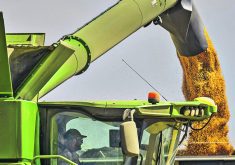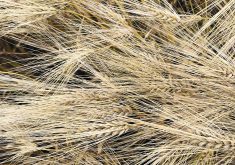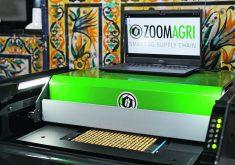SASKATOON — With enough training, an experienced seed grower or grain inspector can tell the difference among different varieties of barley, although they may need to take a closer look with a 10x lens or even a binocular microscope.
But what if they’re stumped, or the variety for a particular sample is unknown? A genetic test will tell the tale, but these are expensive and can take a week or more to turn around.
Olha Zahoruiko with the Canadian Malting Barley Technical Centre (CMBTC) is evaluating an artificial intelligence-driven solution from ZoomAgri in Argentina that promises to deliver fast, accurate and economical variety identification.
Read Also

New program aims to support plant-based exports to Asia
Understanding the preferences of consumers in Taiwan and how they differ from Indonesia or Malaysia isn’t easy for a small company in Saskatchewan.
“They introduced quick and cost-effective analysis for barley variety testing that takes only three minutes and costs about $15; it depends on the country,” Zahoruiko said in a presentation at the Interprovincial Seed Growers Associations Meeting in Saskatoon Nov. 14.
Zahoruiko was first introduced to the technology in her native Ukraine in 2017 and 2018, where local maltsters used to identify imported barleys and as a tool for their own barley multiplication programs. She said the company’s machines are now established in more than 20 countries around the world. When she came to Canada, she saw the opportunity to bring AI seed identification here.
Through the CMBTC, Zahoruiko and her colleagues have been “teaching” the ZoomAgri machine with Canadian malt barley varieties, creating high-resolution scans of more than 250 samples from different classes, locations and harvest years.
“After digitizing, their images are stored in a database and there they serve as the foundation for training the algorithm to recognize varieties,” she said.
The ZoomAgri machine looks much like a scanner or photocopier that one might find in any office. A special holder to separate individual seeds sits on top of the scanner bed. The sample — about a cup or several hundred seeds — is poured onto the holder and then spread out.
Once activated, the machine scans the sample and compares the captured images with its internal database. It then identifies it as a known variety or a mix — for example, 90 percent Copeland and 10 percent unknown. Zahoruiko presented findings that show the machine achieves near-parity with genetic testing for varietal recognition.
“It just seemed too good to be true,” said Todd Hyra, western business manager with SeCan in Winnipeg, one of the partners in the CMBTC, which has members from the entire malting barley value chain as well as relevant provincial and national government organizations.
“When we met with Marco and Augustine from ZoomAgri back in May, it seemed pretty wild to be able to take a high-resolution digital scan and train it, when the speed of it just seems so out of this world.”
Hyra said SeCan staff collected samples and sent them to the CMBTC.
The samples first underwent DNA analysis to ensure varietal purity. Then, they were used to train the ZoomAgri machine. By September, the algorithms had enough data for a hot test.
Hyra and his colleagues came to the meeting with barley samples for testing. Until then, they had never seen the ZoomAgri machine in action. They put in samples whose provenance they knew, others that were unknown and still others where they had purposely misidentified the variety.
“Literally in two minutes it was able to generate results on some of these samples,” he said.
“It was able to nail them every time. Even if we told them it was something different, it would spit out the proper result.”
Hyra even brought in a sample that had been lying around in his garage for 10 years, left over from outreach work he had been doing with schools. It turned out to be 100 percent AC Metcalfe, a popular variety at the time.
What makes the technology even more remarkable, Hyra said, is that malting barley varieties not only look a lot alike, but the appearance of varieties can vary depending on region and growing conditions. By providing a wide range of samples from a wide range of growing conditions to start with, the machine learning algorithms are able to assimilate it all.
“I was talking to one of the folks from Argentina about it. He said, ‘you just train it.’ He doesn’t even know what it’s looking for,” Hyra said.
Fast and accurate varietal confirmation will find obvious applications for large maltsters and exporters, for whom varietal purity is vital, Hyra said. For example, a maltster could receive assurance that an entire 400-tonne batch is as close as possible to 100 percent CDC Fraser or CDC Churchill.
The technology might be less useful to maltsters working with heritage varieties because the ZoomAgri machines might not yet have “learned” these less popular barleys with their algorithms.
“When it can be essentially done on every truckload that’s being added to a bin, it just heads off any issues with contamination or mixing of varieties,” Hyra said.
That said, he sees the ZoomAgri technology as a complement rather than replacement for existing seed variety certification process.
A fast way to check for variety and varietal purity could be a valuable addition to a seed grower’s tool kit.
“They’ll use their own processes to keep it pure, but this provides that extra check for relatively low cost; just extra peace of mind,” he said.
Mitchell Japp, research and extension manager with SaskBarley, another CMBTC partner, agrees the ZoomAgri technology will likely be a supplement to the gold-standard DNA testing, albeit a “game changing” one for producers. After all, genetic testing still takes five to seven days, which cannot keep up with the pace of production and deliveries.
“This will allow an elevator to have a technology in place that allows them to get the result before they dump.”
This gives producers more control of a given load, Japp said. Currently, if a load of barley fails the genetic test and it’s already been delivered, it gets downgraded to feed. A fast, accurate varietal test at the elevator would allow a producer to haul a load back home to consider other marketing options.
“If it proves to be robust enough to be used in the varietal purity testing associated with malting barley, where the industry is looking for 95 percent or better purity, if that can be used in an in line elevator, a producer would have that option to say, ‘yeah, these results look great, dump it,’ ” Japp said.
From the grain buyer’s standpoint, a fast and accurate testing method would also allow more frequent testing rather than testing by bin or lot. Japp said the technology may be less attractive at the seed grower level, where tried and true genetic testing can more easily be used because time is less of an issue.
“I can’t speak for sure to the seed industry, but for the barley producer who’s selling to a malt company or a line company with their malting barley, that’s where I see the potential.”

















